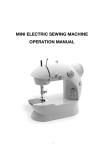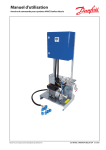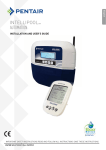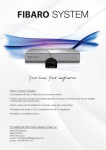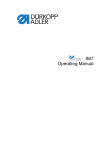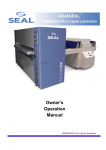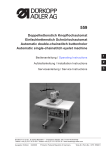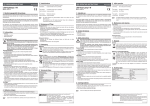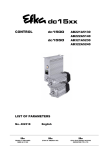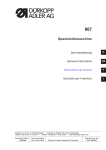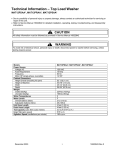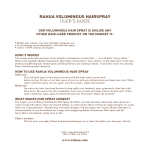Download Part 1: Operating Instructions Class 550-16-26
Transcript
Contents Page: Preface and General Safety Information Part 1: Operating Instructions Class 550-16-26 1. Product Description . . . . . . . . . . . . . . . . . . . . . . . . . . . . . . . . . . . . . . . . . . . . 5 2. Proper Use . . . . . . . . . . . . . . . . . . . . . . . . . . . . . . . . . . . . . . . . . . . . . . . . . . 5 3 Technical Data . . . . . . . . . . . . . . . . . . . . . . . . . . . . . . . . . . . . . . . . . . . . . . . 6 4. 4.1 4.2 4.3 4.4 4.5 4.6 4.7 4.8 4.9 4.10 4.11 4.12 4.13 4.14 4.15 Operation Threading the Needle Thread . . . . . . . . . . . Setting the Needle Thread Tension . . . . . . . . Releasing the Needle Thread Tension . . . . . . Setting the Thread Regulator . . . . . . . . . . . Winding the Hook Thread . . . . . . . . . . . . . Changing the Hook Thread Bobbin . . . . . . . . Setting the Hook Thread Tension . . . . . . . . . Changing the Needle . . . . . . . . . . . . . . . . Sewing Foot Lift . . . . . . . . . . . . . . . . . . . Arresting the Sewing Foot in the High Position . Setting the Sewing Foot Pressure . . . . . . . . Stroke Height of the Sewing Foot during Lifting Pulsating sewing foot . . . . . . . . . . . . . . . . Knee Switch . . . . . . . . . . . . . . . . . . . . . Left “Correction Value” / Fullness Value Pedal . . . . . . . . . . . . . . . . 7 9 9 10 11 12 13 14 15 16 16 17 17 18 18 5. Operating the Controls 550-16-26 . . . . . . . . . . . . . . . . . . . . . . . . . . . . . . . . . . . 19 6. Sewing . . . . . . . . . . . . . . . . . . . . . . . . . . . . . . . . . . . . . . . . . . . . . . . . . . . . 19 7. 7.1 7.2 Maintenance Cleaning and Checking . . . . . . . . . . . . . . . . . . . . . . . . . . . . . . . . . . . . . . . . . . . Lubrication . . . . . . . . . . . . . . . . . . . . . . . . . . . . . . . . . . . . . . . . . . . . . . . . . . 20 22 . . . . . . . . . . . . . . . . . . . . . . . . . . . . . . . . . . . . . . . . . . . . . . . . . . . . . . . . . . . . . . . . . . . . . . . . . . . . . . . . . . . . . . . . . . . . . . . . . . . . . . . . . . . . . . . . . . . . . . . . . . . . . . . . . . . . . . . . . . . . . . . . . . . . . . . . . . . . . . . . . . . . . . . . . . . . . . . . . . . . . . . . . . . . . . . . . . . . . . . . . . . . . . . . . . . . . . . . . . . . . . . . . . . . . . . . . . . . . . . . . . . . . . . . . . . . . . . . . . . . . . . . . . . . . . . . . . . . . . . . . . . . . . . . . . . . . . . . . . . . . . . . . . . . . . . . . . . . . . . . . . . . . . . . . . . . . . . . . . . . . . . . . . . . . . . . . . . . . . . . . . . . . . . . . . . . . . . . . . . . . . . . . . . . . . . . . . . . . . . . . . . . . 1 1. Product Description The Dürkopp Adler 550-16-26 is a configured sewing station for the sewing-on of sleeves. The workstations are equipped with a single needle, double lockstitch, post-bed machine with bottom and top belt feed. 30 different fullness values can be selected via the keypad. In order to achieve a firmer pulling-on of the stitch, a supplementary tension can be added when a high fullness value is turned on. Further details: • • 2. Step motor technology for top and bottom belt feed. Material-protective belt feed with two individually powered belts for the top and bottom feed. Proper Use The 550-16 is a sewing place which can properly be used for sewing litght to medium weight material. Such material is, as a rule, material made up of textile fibres. This material is used in the garment industry. Further, it may be possible to also conduct so-called technical seams with this special sewing machine. Here, however, it is essential that the operator (Dürkopp Adler AG would be pleased to collaborate) make an evaluation of the possible dangers because such applications are, on the one hand, comparatively rare and, on the other, the variety is immense. Dependent of the result of this evaluation, appropriate safety measures are to be taken. Generally, only dry material should be sewn on this machine. The material should not exceed the thickness of 7 mm when compressed by the lowered sewing foot. The material should not contain any hard objects, otherwise it would be necessary to protect the eyes during the sewing process. For the time being, no such guard is available. The seams are produced generally with threads of textile fibres of a dimension up to 70/3 - 140/3 NeB. Before using any other threads it is necessary, also in this case, to estimate the consequential dangers and to take, if necessary, the respective safety measures. This special sewing machine may only be installed and operated in a dry and clean environment. If the sewing machine is used in another environment which is not dry and clean, further measures, which are to be agreed upon, may be necessary (see EN 60204-31:1999). We, as a manufacturer of industrial sewing machines, assume that at least semi-skilled operating personnel will be working on our products so that all normal operations and, where applicable, their dangers are presumed to be known. 5 1 3. Technical Data Noise Workstation-specific emission value to DIN 45635-48-A-1-KL2 Cl. 550-16-26 Lc = Stitch length: Number of stitches: Material: 79 dB (A) 4,4 [mm] 2.500 [min -1 ] G1 DIN 23328 2-plies Stitch type Double lockstitch Needle system: 134 - 35 797 Sy1955-1 Needle thickness (as per E-No.:) [Nm] 70 - 100 Thickness of sewing thread max.: [Nm] 50/3 Number of stitches max.: [min -1 ] Stitch length max.: [mm] Max. clearance under the sewing feet: - Sewing - Lifted [mm] [mm] Operating pressure: [bar] Air consumption per work cycle: approx. [NL] Nominal voltage: 1,5 - 5,5 6 0,6 190-240V 50/60 Hz Dimensions(L x B xH) [mm] 140 x 750 x 1300 Working level (ex works): [mm] 790 [kg] 140 Weight 6 4.000 4. Operation 4.1 Threading the Needle Thread Caution Risk of Injury ! Turn the main switch off ! Thread the needle thread only with the sewing machine turned off. – – Place the thread rolls on the thread stand and guide the needle and the hook thread through the thread guides. The thread guide 1 must be in vertical position above the thread rolls. Thread the needle thread as shown in the illustration. 1 1 7 3 8 2 1 4 Illus. A: Correct thread interlacing in the middle of the material Illus. B: Needle thread tension too low or hook thread tension too high high Illus. C: Needle thread tension too high or hook thread tension too low 4.2 Setting the Needle Thread Tension Pre-tension With open main tension 3 a slight residual tension on the needle thread is necessary. The residual tension is created by pre-tension 1. The pre-tension 1 influences the length of the cut needle thread end at the same time (starting thread for the next seam). – Base position: Turn the knurled nut 1, until its face is flush with bolt 2. – Shorter starting thread: Turn knurled nut 1 clockwise. Main tension The main tension 3 is to be set as low as possible. The interlacing of the threads should lie in the middle of the material. Too high thread tensions can lead to undesired puckering and thread breakage in thin material. – Set the main tension 3 so that a uniform stitch formation is achieved. Increase tension = Turn the knurled nut clockwise Decrease tension = Turn the knurled nut counterclockwise 1 ATTENTION ! The main tension can be opened through the control. (e.g. for sewing Polsters) Supplementary tension The supplementary tension 4 can be switched on for thicker gathering (programmable). – Set the supplementary tension 4 lower than the main tension 3. 4.3 Releasing the Needle Thread Tension Automatic The needle thread tension is automatically opened during thread trimming and lifting of the sewing foot. 9 4.4 Setting the Thread Regulator 7 6 5 Caution Risk of Injury ! Turn the main switch off . Set the thread regulator only with the sewing machine turned off. The needle thread quantity required for stitch formation is regulated by the thread regulator 6. Only a precisely set thread regulator assures an optimal sewing result. With a correct setting the needle thread loop must glide over the thickest part of the hook with a light tension. – Loosen screw 5. – Set the position of the thread regulator. – Tighten screw 5. Setting note: When the largest thread quantity is required, the check spring 7 must be pulled up approx. 0.5 mm from its upper end position. This is the case when the needle thread loop passes the maximum hook circumference. 10 4.5 Winding the Hook Thread 4 3 – – – – – 2 1 1 Slip the bobbin onto the bobbin winder 2. Pull the thread through the guide 3 and the tension 4. Wind the thread clockwise about 5 times around the bobbin core and tear off at the thread clamp. Swing the bobbin winder lever 1 towards the bobbin . Sewing The bobbin winder lever will stop the winding process as soon as the bobbin is full. ATTENTION ! If the thread is not to be wound during sewing, it is essential to arrest the sewing foot in the raised position. (See chapter 4.10) 11 4.6 Changing the Hook Thread Bobbin 3 4 1 7 6 2 5 1 Caution Risk of Injury ! Turn the main switch off . Change the hook thread bobbin only with the machine turned off. Removing the empty bobbin – Swing the hook cover 2 down. – Bring the needle bar in high position. – Lift the bobbin case flap 1. – Take out the bobbin case top 3 with the bobbin 7. – Remove the empty bobbin from the bobbin case top 3. Inserting a full bobbin – Insert the full bobbin in the bobbin case top 3. – Pull the hook thread through slit 6 under the tension spring 5 until in the drilled hole 4. – Pull the hook thread approx. 5 cm out of the bobbin case 3. The bobbin must turn in the direction of the arrow when the thread is pulled off. – Insert the bobbin case 3 again. – Close the bobbin case flap 1. – Swing the hook cover 2 up. 12 4.7 Setting the Hook Thread Tension 8 5 10 3 Caution Risk of Injury! Turn the main switch off . Set the hook thread tension only with the machine turned off. 1 Half of the necessary hook thread tension should be created by the brake spring 8 and halb by the tension spring 5. Setting the tension spring – The bobbin case top 3 should slowly lower under is own weight (see right illustration). – Set the tension spring 5 at the adjusting screw 10 until the necessary tension value is reached. Note: The hook thread tension should amount to 20 +/- 5 grams. 13 4.8 Changing the Needle 3 1 2 Caution Risk of Injury! Turn the main switch off . Change the needle only with the sewing machine turned off. – – – Loosen screw 1. Push the new needle into the drilled hole of the needle bar 3 up to the stop. ATTENTION ! The furrow 2 of the needle must show to the hook point. Tighten screw 1. ATTENTION ! After a change to another needle thickness the clearance of the hook to the needle must be corrected (see Service Instructions). The non-observance of the above correction can lead to following faults: – Change to a thinner needle: - Missing stitches - Damage to the thread – Change to a thicker needle: - Damage to the hook point - Damage to the needle 14 4.9 Sewing Foot Lift 4 1 The sewing foot can be lifted pneumatically by operating the pedal 4. Pneumatic sewing foot lift (pedal) – Step half back on the pedal. Lift the sewing feet. – Step completely back on the pedal. Activate the thread trimmer and lift the sewing feet. 15 4.10 Arresting the Sewing Foot in the High Position 3 2 1 The pneumatically raised sewing foot can be arrested in the high position with button 3 (e.g. for winding the hook thread). – With the sewing machine idle, step half back on the pedal. The sewing foot lifts. – Press button 3 and release the pedal. The raised sewing foot is arrested in the high position. – Step half back on the pedal again. The sewing foot is released. 4.11 Setting the Sewing Foot Pressure The desired sewing foot pressure is set with the knurled screw 1. – Loosen lock nut 2. – Increase the sewing foot pressure Turn screw 1 clockwise. – Decrease sewing foot pressure Turn screw 1 counterclockwise. – Tighten lock nut 2 again. 16 2 5 1 4 3 4.12 Stroke Height of the Sewing Foot during Lifting The stroke height of the sewing foot during lifting can be limited by the knurled nut 1. – Loosen the lock nut 2. – Increase the stroke of the sewing foot Turn the knurled nut 1 counterclockwise. Decrease the stroke of the sewing foot Turn the knurled nut clockwise. ATTENTION ! The stroke height of the sewing foot should not be so high that the needle bar strikes on the foot when the machine turns. 4.13 Pulsating sewing foot In order to facilitate the rolling of the material in the arc, the sewing foot will be lifted with the needle frequency synchronously. The height could be adjusted using the setting wheel 3. – Position 0 on the setting wheel 3 à no stroke of the sewing foot. – Position 10 on the setting wheel 3à maximum stroke. ATTENTION Thinner Material à lesser stroke. Thicker Material à greater stroke. Normal Material à position between 2 and 4 on the setting wheel. Basic settings – Position the needle at the lower reversal point. – Turn the setting wheel in a way that the figure 2 is turned towards the operator. – Loose the Allen screw 5 and turn the disc 4 to the right until the sewing foot slightly lifts. – Tighten the Allen screw 5. 17 1 4.14 Knee Switch 2 1 With the knee switch 1 one moves from one program step to the next in the sewing programs. – Press the knee switch. The next program step is called up. 4.15 Left “Correction Value” / Fullness Value Pedal The left pedal 2 has a dual function. 1. Automatic operation In automatic operation the fullness value can be corrected with the pedal. 2. Manual operation In manual operation the individual fullness levels are selected with the pedal. 18 5. Operating the Controls 550-16-26 The operating of the control is described in part 4: “Programming instructions” 6. Sewing Sewing cycle Operation / Remarks V Before the start of sewing Initial position - Pedal in rest position. Sewing machine idle. Needle up. Sewing foot down. Positioning the material at the seam beginning - Step half back on the pedal. The sewing foot rises . - Position the material. - Release the pedal. The sewing foot lowers onto the material. 1 Beginning the seam Beginning bartack and continuing to - Step forward on the pedal and hold down. sew The beginning bartack is sewn (if given). Then the machine continues to sew at the speed determined with the pedal. At the middle of the seam Interrupting the sewing cycle - Release the pedal (rest position). The machine stops. The sewing foot is down. Continuing the sewing cycle - Step forward on the pedal. The machine sews at the speed determined with the pedal. Z Sewing an intermediate bartack bartack Changing the fullness value - Press the key [OH] and hold the pedal down. The machine sews in reverse as long as key [OH] is pressed. The speed is determined by the pedal. - Operate the fullness key or left pedal. The changed fullness value is activated. At the seam end Remove the material - Step completely back on the pedal and hold down. The end bartack is sewn (if given). The thread is trimmed. The machine stops in the 2 nd position. The sewing foot is raised. 19 7. Maintenance 7.1 Cleaning and Checking Caution Risk of Injury! Turn the main switch off . Conduct maintenance work only with the machine switched off. The maintenance work must be carried out at least at the intervals specified in the tables (see the column “Service hours”). When working very linty materials, shorter maintenance intervals may result. A clean machine protects against malfunctions. 1 Maintenance work to be carried ou Explanantion Machine head - Remove sewing dust and thread ends. (e.g. with compressed-air gun) 20 Clean particularly: - the bottom of the throat plate - transporter bars - the space around the hook 1 - the bobbin case - thread trimmer - the space around the needle Service hours 8 6 4 8 1 2 10 2 3 Maintenance work to be carried out Explanantion Service hours Pneumatic System - Check water level in the pressure regulator. - Clean the filter element. - Check the tightness of the system. The water level should not reach the filter element 1. - After turning-in the draining screw 3 drain the water separator 2 under pressure. The filter element 1 separates dirt and condensed water. - Disconnect the machine from the compressed air line. - Turn-in the draining screw 3. The pneumatic system of the machine must be pressure-free. - Unscrew the water separator 2. - Unscrew the filter element 1. Wash the dirty filter tray and the filter element with petroleum benzine (no solvent!) and blow clean by compressed air. - Re-assemble the conditioning unit. 1 40 500 500 21 7.2 Lubrication 1 Caution Risk of Injury ! Oil can cause skin rashes. Avoid longer skin contact. After contact wash yourself thoroughly. ATTENTION ! The handling and disposal of mineral oils is subject to legal regulations. Deliver used oil to an authorized reception point. Protect your environment. Take care not to spill any oil. For lubrication of the special sewing machine, use exclusively the lubrication oil ESSO-SP-NK 10 or an equivalent oil with the following specification: – Viscosity at 40° C: 10 mm²/s – Flash point: 150° C ESSO SP-NK 10 can be obtained from the sales offices of DÜRKOPP ADLER AG under the following parts numbers: 2 liter container: 9047 000013 5 liter container: 9047 000014 Maintenance work to be carried out Lubrication of the machine head Explanation The lubrication of the machine head occurs via a central oil wick system. Except for the hook all bearings are lubricated via the oil reservoir 1. - The oil level should not drop below the mark “MIN” . - Fill oil up to the “MAX” mark through the drilled hole in the viewing glass. 22 Servicehours 40



















